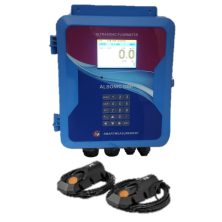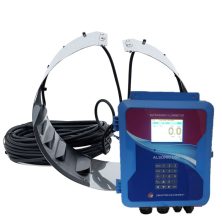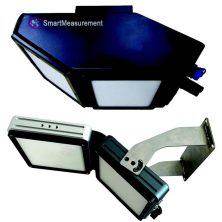Open Channel Flow Meters
SmartMeasurement offers advanced Area Velocity Meter(AVM) open channel solutions, such as the non-intrusive Alsonic RAVM, as well as wetted transducer designs like the transit-time ALSONIC AVM and the Doppler-type ALSONIC-DAVM. For sewer pipes and other partially filled cylindrical conduits, the special-purpose ALSONIC-SAVM transit time meter is offered.
Featured Products
Explore SmartMeasurement’s most popular open channel flow meters—engineered for precise, non-intrusive measurement in water treatment, HVAC, energy, and industrial systems. Easily compare models by installation type, application, or feature set to find the right fit for your project.
Not sure which model fits your system? Talk to an Engineer for expert guidance.
ALSONIC-AVM
- Size Range: Sizes 3'-130' (1-40 m)
- Temperature Range: Ambient, transducers can withstand temperatures of 248°F (120°C)
- Accuracy: 0.5-1%
- Applications: Open channel; clean and dirty water
- Starting At: $8,000
ALSONIC-SAVM
- Size Range: Sizes 6''-48" (100-1200 m)
- Temperature Range: Ambient, transducers can withstand temperatures of 248°F (120°C)
- Accuracy: 0.5-1%
- Applications: Clean or dirty sewers
- Starting At: $8,000
ALSONIC-DAVM
- Size Range: Sizes 6"-240" (150-6000 mm)
- Temperature Range: Ambient, transducers can withstand temperatures of 248°F (120°C)
- Accuracy: 2-5%
- Applications: Economic open channel monitoring, mainly used for sewers and surveying
- Starting At: $5,000
ALSONIC-RAVM
- Size Range: Level 0-70 meters channel up to 100 meters
- Temperature Range: Seal proof dew and condensate <65C enclosure IP68 or IP67
- Accuracy: +/- 0.01m/s +/-1%
- Applications: Rivers, lakes, tides, reservoir gates, sewage pipe networks, irrigation channels, etc.
- Starting At: $6,000
Need help choosing the right open channel flow meter?
Our engineers can match you with the best model based on your specs and budget.
Why Choose SmartMeasurement’s Open Channel Flow Meters?
At Smart Measurement, we specialize in providing innovative and reliable open channel flow measurement solutions for a wide range of industries. Our extensive product line includes state-of-the-art ultrasonic transit-time, radar combined with microwave Doppler, partially filled magnetic as well as traditional Doppler open channel flow meters, each designed to deliver accurate and dependable performance in challenging environments. Our expert team is dedicated to helping customers find the perfect open channel flow meter for their unique needs, offering personalized support and customized solutions.
Non-Intrusive Measurement for Easy Maintenance
Utilizing microwave doppler with radar level transmitter our AlsonicRAVM meters measure open channel flow without ever touching the liquid to reduce fouling, wear, and ongoing maintenance
Ideal For Partially Filled Channels
Perfect for canals, streams, and sewer systems, these meters accurately calculate flow in trapezoidal, rectangular, and custom-shaped channels.
Customizable for Harsh Environments
Built with flexible sensor options and rugged enclosures, these meters perform reliably in outdoor, corrosive, or hazardous locations.
Solutions for Special Use Cases
ALSONIC-SAVM: Transit-Time Solutions for Sewers
SmartMeasurement offers the ALSONIC-SAVM, a variant of the ALSONIC-AVM, specifically designed for cylindrical conduits like those in sewer systems. This model excels in profiling velocities in small channels, even with limited straight runs, making it ideal for sewer applications.
Design and Functionality
The ALSONIC-SAVM is tailored for sewer pipes or round conduits ranging from 6-60 inches (150-1500mm). It features the same display module as the ALSONIC-AVM but is equipped with a pre-configured cylindrical 3 or 4-path transducer array, ensuring easy installation. This array calculates flow velocity with the same high accuracy as the standard ALSONIC-AVM.
Efficient and Accurate
Designed for adaptability and precision, the ALSONIC-SAVM is an optimal solution for measuring flow in round sewer pipes without worrying about sedimentation or blockage offering the reliability and accuracy synonymous with SmartMeasurement’s ultrasonic technology.
Discover more about our Ultrasonic Water Technology and its applications here.
Key Features and Functionality
- Advanced Transit Time Transducers: Able to measure very clean liquids as well as dirty liquids of up to 30% particles or bubbles.
- Ability to incorporate any Level Transmitter technologies: Users can choose any level technologies best suited for their application and connect the analog output to the SAVM flow computer for optimum Area Velocity Measurements.
- High Accuracy: Accuracies of up to 0.5% of reading can be achieved for either clean or dirty liquids.
Advantages of ALSONIC-SAVM
- Most accurate sewer system, or round channels in the market: Accuracies of up to 0,5% of reading can be achieved for either clean or dirty liquids.
- Easy Installation: Fits snugly inside cylindrical open channel conduits of 6-60 inches (150-1500mm)
- Versatile Display Options: Graphic display providing signal strengths, sound speeds, and various information pertaining to open channel measurements.
Examples of Open Channel Flow Meter Installations

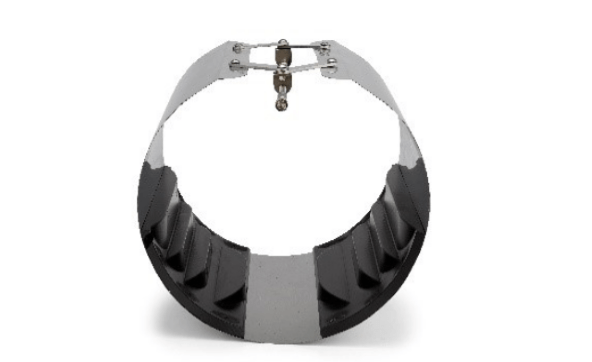
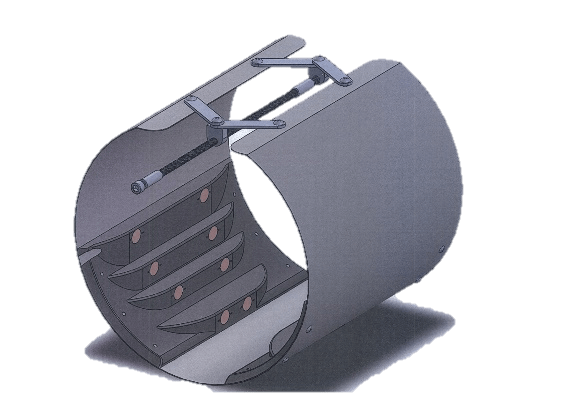

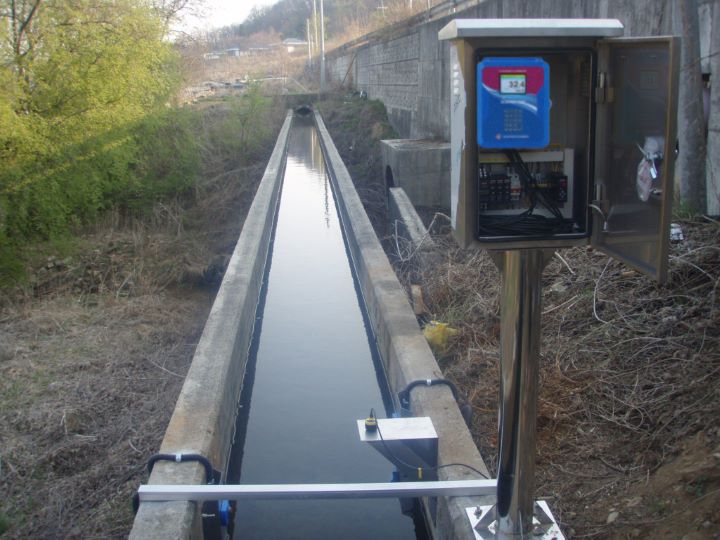
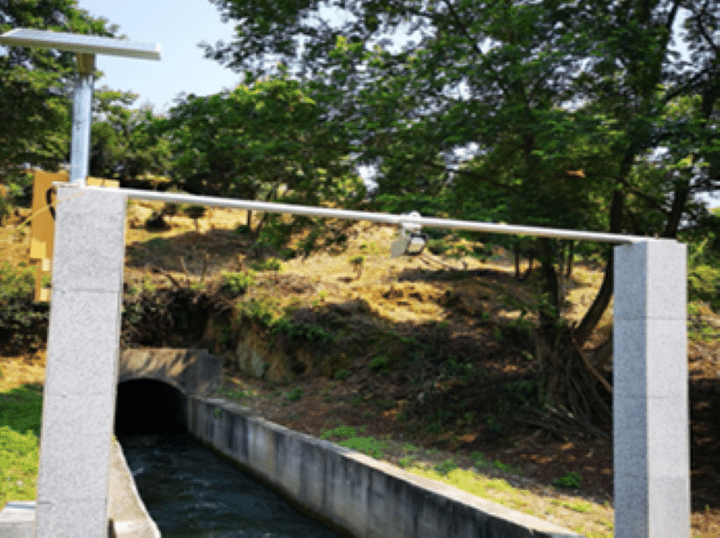
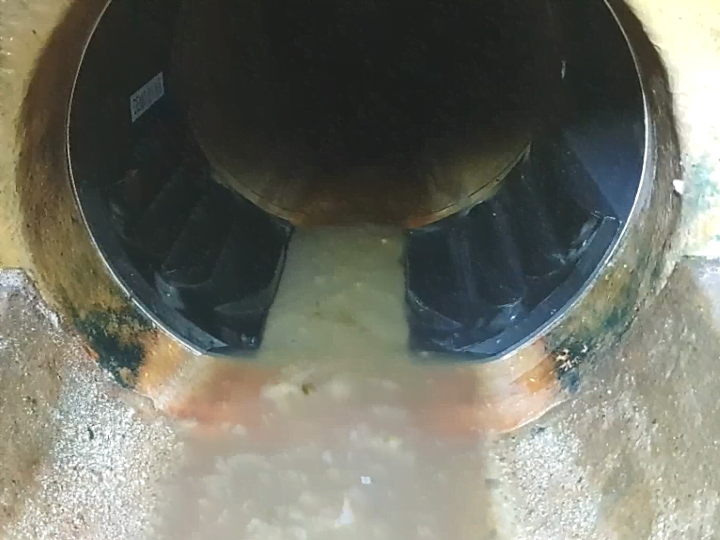
ALMAGPF: Magnetic Flow Meter for Partially Filled Closed Pipes
To compensate for overflow due to rain and surges municipalities of times required swage piping in which the pipe is never full so to compensate for overflow flows. These are called partially filled pipes where standard flow metering requiring continuous filled pipes will not work. These partially filled applications require a flowmeter that measures fluid velocity as well as the liquid level in the pipe.
SmartMeasurement’s ALMAG PF is an electromagnetic Partially Filled Pipe Flow Meter featuring an electromagnetic flow velocity sensor combined with a ultrasonic liquid level sensor for a complete and continuous Area Velocity flow measurement. Users only need to input the inner diameter of a circular pipe, and the Almag PF will automatically calculate the flow rate in the pipe. The Almag PF transmitter automatically displays the instantaneous flow, flow velocity, cumulative flow and other measure- ment parameters in the pipeline. Compared with flowmeters measuring the flow rate by means of level measurement,, the obstruction-less ALMAG PF flow-meter is not affected by mud, sands and other solid sediment because the sensors are on the opposite sides of the flow body. It is also unaffected by waves or floating solids on the fluid surface.
Specifications
- Used for partially filled closed pipes
- Pipe Sizes:2″-40″ (100-1000mm)
- Accuracies of ±2.5% FS
- For Liquids w/ electrical conductivity ≤ 100 μS/cm
- 0-130°F(0-55°C)
- Neoprene or Hard rubber liners with 316SS ,316L, Ti, Hastelloy C electrodes Flanged (DIN, ANSI, JIS etc.)
- Applications are for storm surge, drainage systems, discharge control
- Water and Wastewater, agricultural industries
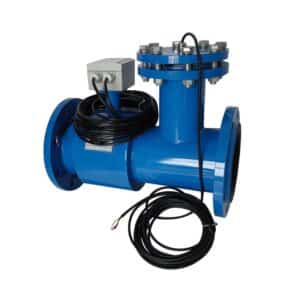
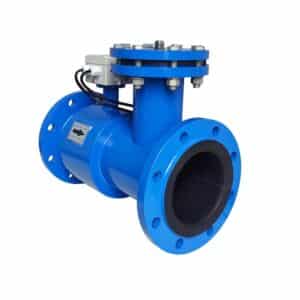
What Are Open Channel Flow Meters?
Open channel flow meters are specialized instruments designed to measure the flow of liquids in channels, streams, or partially filled pipes where the flow is not under pressure. Unlike traditional closed-pipe meters, they determine flow rate by calculating both the liquid level and velocity using separate sensors. Typically ultrasonic or electromagnetic for velocity, and any level technologies, for level measurement.
These meters rely on area-velocity measurement (AVM), combining data from both sensors and a flow computer to provide accurate, real-time flow profiling. Open channel flow meters are ideal for applications like wastewater treatment, irrigation systems, and stormwater monitoring. Compared to outdated flumes and weirs, which degrade and collect sediment over time, modern open channel meters offer far greater accuracy and long-term reliability without relying solely on channel shape.
How Open Channel Flow Meters Work
Area Velocity Flow Meters
Area velocity flow meters differ from other types by combining a velocity sensor with an ultrasonic level sensor to calculate the flow rate. This technology offers several advantages for certain applications, such as:
- Accurate flow measurement in partially filled pipes or channels with irregular shapes
- Ability to handle a wide range of flow rates and velocities
- Reduced installation costs compared to flumes or weirs
Open channel flow meters rely on two key measurements to determine the flow rate:
- Liquid level: The height of the liquid surface in the channel
- Velocity: The average speed of the liquid flowing through the channel
By multiplying the cross-sectional area of the flow (calculated using the liquid level and channel dimensions) with the average velocity, the flow meter can accurately compute the volumetric flow rate using the following equation: Flow Rate (Q) = Cross-sectional Area (A) × Average Velocity (V)
Several technologies are employed in open channel flow meters to measure liquid level and velocity:
 Robert Manning (22 October 1816 – 9 December 1897) was an Irish hydraulic engineer best known for creation of the Manning formula. The Mannings equation is an empirical equation that applies to uniform flow in open channels and is a function of the channel velocity, flow area and channel slope. Under the assumption of uniform flow conditions the bottom slope is the same as the slope of the energy grade line and the water surface slope.
Robert Manning (22 October 1816 – 9 December 1897) was an Irish hydraulic engineer best known for creation of the Manning formula. The Mannings equation is an empirical equation that applies to uniform flow in open channels and is a function of the channel velocity, flow area and channel slope. Under the assumption of uniform flow conditions the bottom slope is the same as the slope of the energy grade line and the water surface slope.
Q = a x 1.486/n x R2/3 x S1/2
Input Data: Area = ft² Mannings ‘n’ = Wetted Perimeter = ft Slope = ft/ft
Results: Hydraulic Radius = ft Flow Rate = cfs Velocity = ft/s
Fluid velocity is measured by sending an ultrasonic pulse from an upstream transducer to a downstream transducer and back again. These signals are emitted alternately in the flow direction and against it. As the fluid in which the signals propagate is flowing, the transit time of the ultrasonic signals in the flow direction is shorter than against the flow direction. The resulting difference in transit time, ∆t, is measured and allows the flowmeter to determine the average fluid velocity along the propagation path of the ultrasonic signals. A flow profile correction is then performed in order to obtain the area averaged flow velocity, which is proportional to the volumetric flow rate based on user-entered information about the process application.
- Ultrasound pulses are propagated in an angle both from the upstream and downstream, and flow rate is measured by detecting the time difference generated with the flow.
- Suitable for clean fluid

- Ultrasound pulses are transmitted into a liquid, and flow velocity profile is found and the flow rate is measured by using the characteristics that Doppler frequency of the echo from reflectors such as air bubbles and particles in the liquid changes according to flow velocity.
- Suitable for opaque fluid
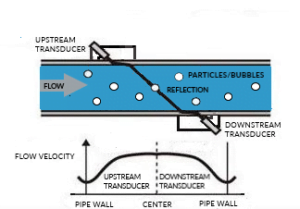
Level measurement using radar technology is based on the reflection of microwaves on surface media. All media have a dielectric constant. The higher it is, the stronger the reflection of the microwaves will be. Vacuum gives no reflection at all and has a dielectric constant of 1. Radar level transmitters use top-down waveguides to generate and direct microwave pulses downwards into a containment vessel. These signals propagate through the headspace due to the low dielectric constant, or relative permittivity (Er), of gas and vapor.
Open Channel Flow Meter Applications
SmartMeasurement’s open channel flow meters are designed for accurate, flow monitoring in partially filled pipes, culverts, channels, rivers, streams, etc.. These meters are ideal for a wide range of industry applications where pressurized flow measurement isn’t possible, offering precise readings with minimal maintenance. Common use cases include:
Water Resource Management
Monitor river, stream, and irrigation channel flow rates to optimize water usage, support conservation efforts, and manage reservoir releases. Ideal for agricultural and environmental flow monitoring.
Wastewater Treatment
Measure influent and effluent flow in treatment facilities to support compliance with EPA discharge regulations and improve process efficiency in municipal and industrial wastewater systems.
Stormwater and Drainage Systems
Track flow in stormwater channels, retention basins, and culverts to mitigate flood risk, manage runoff, and ensure regulatory reporting accuracy during peak weather events.
Industrial Effluent Monitoring
Accurately measure discharge flow from industrial facilities such as chemical plants, food processing plants, and manufacturing operations to ensure adherence to environmental standards.
Agricultural Irrigation Systems
Optimize irrigation flow in canals, ditches, and furrows with precise area-velocity measurement. Monitor water usage, improve crop yield efficiency, and meet regional water management requirements in both small-scale farms and large agricultural operations.
With wide pipe size ranges as well as compatibility across different liquid and gas types, SmartMeasurement’s open channel flow meters are the preferred choice for flow measurement solutions.
